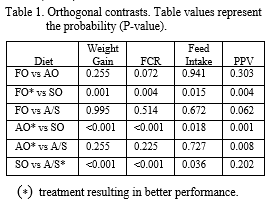UTILIZATION OF OPEN-FORMULA DIETS FED TO FLORIDA POMPANO Trachinotus carolinus TO EVALUATE MICROALGAE OIL SUBSTITUTION FOR FISH OIL
There is interest in reducing the use of rendered fish oil (FO) in fish feeds. There are an increasingly diverse array of alternative s; however, suitability requires accurate information on the nutritive value of a prospective alternative. There is increasing interest in utilizing microalgal oils as a partial replacement/supplement to FO, particularly the heterotrophic microalgae Schizcochytrium
The specific objectives of the study were: 1) to evaluate performance of four experimental fishmeal (FM) free diets, each with different supplementary oil sources relative to an open-formula FM based diet; and 2) evaluate performance of the four different oil supplements relative to each other.
Five experimental diets were formulated as iso-nitrogenous and iso-lipidic. The control diet (FM) contained FM and FO and other ingredients common in commercial feeds. The remaining four diets were FM free and varied only in lipid containing either fish oil (FO), algal oil (AO), soy oil (SO), or an algal/soy oil (50/50) blend (A/S). The AO (Veramaris® ) is a liquid product extracted from whole cell, heterotrophic microalgae Schizochytrium sp. The SO diet served as a negative control. The A/S diet was evaluated to determine if the very high levels of DHA found in AO are necessary. Oil supplements were incorporated at 10.8% of the dry diet.
The experiment was a completely randomized design with four replicate tanks. Tanks were stocked with 20 pompano ( = 4.1g) and fed four times/day ad libitum . The experiment lasted 85 days. D ata were analyzed as a one-way ANOVA. The FM control was tested against the other four experimental diets using Dunnett's t-test. The diets differing only in oil sources were tested against each other using orthogonal contrasts. Significant differences were declared at P<0.05.
Of the AO, SO, and A/S diets, only the SO diet was significantly different than the FM control in almost all parameters evaluated. The protein productive value (PPV) of AO was not different than the FM control, whereas FO, SO, and A/S were. The results of the contrasts indicate performance of the
SO fed fish were lower than the other oil sources (Table 1). The data suggest within the similar diets varying only between supplemental oil sources that Veramaris® algal oil is a suitable alternative to FO, and that diluting it to a 50/50 blend with SO resulted in no decreases in performance other than in PPV.
